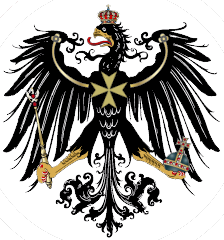Midway between Breslau and Liegnitz in 1843 when the rail line from Breslau to Freiburg met the line from Schweidnitz to Striegau a name was sought for the junction which was in the middle of nowhere. It was thought that this was around the location of the 1761 Bunzelwitz encampment during the Seven Year War. And as the encampment would have included the tent of Frederick The Great – Königszelt (meaning ‘The Kings Tent’) was chosen for the junction town.
 A porcelain company was founded in 1860 at Königszelt by an entrepreneur who chose the location due to the easy access to rich deposits of clay and coal found in the surroundings. As the production costs were very low the business was able to sell items much cheaper than other companies. Company growth was inevitable and high quality and respected porcelain was produced for decades. The example in the featured image bearing the Prussian Eagle (not used again after WW1) mark to the right was crafted in the factory between 1914 and 1918 . Although in the throws of war, the product range was now concentrating on better tableware and export was becoming a focus.
A porcelain company was founded in 1860 at Königszelt by an entrepreneur who chose the location due to the easy access to rich deposits of clay and coal found in the surroundings. As the production costs were very low the business was able to sell items much cheaper than other companies. Company growth was inevitable and high quality and respected porcelain was produced for decades. The example in the featured image bearing the Prussian Eagle (not used again after WW1) mark to the right was crafted in the factory between 1914 and 1918 . Although in the throws of war, the product range was now concentrating on better tableware and export was becoming a focus.
Further acknowledgement of the quality occurred with Königszelt being one of the few German companies licensed to produce Mickey Mouse figurines by Disney. In contrast as the Country rolled into WW2 the Third Reich saw the alignment with Disney as an affront. Königszelt continued with its regular product lines but was commissioned by the Reich to produce a number of commemorative and regular items. Specifically labelled crockery was prepared for generic military and officers use, for the Kriegsmarine, the Luftwaffe, and to commemorate battle victories.
 It is interesting to note that after the forced ethnic cleansing of the native German population after 1945 it only took a short time for most workers from Königszelt to find a new job at Bareuther & Co. (a porcelain factory in Bavaria). This was with enormous financial effort covered by company funds. The combined workforce started providing housing possibilities for the refugees and then started to rebuild the facility. Bareuther & Co (almost destroyed during wartime) was one of the first large facilities to be fully operational in 1949 and already having a workforce of 417 people. Initially this new concern concentrated on producing staple needs for devastated German homes.
It is interesting to note that after the forced ethnic cleansing of the native German population after 1945 it only took a short time for most workers from Königszelt to find a new job at Bareuther & Co. (a porcelain factory in Bavaria). This was with enormous financial effort covered by company funds. The combined workforce started providing housing possibilities for the refugees and then started to rebuild the facility. Bareuther & Co (almost destroyed during wartime) was one of the first large facilities to be fully operational in 1949 and already having a workforce of 417 people. Initially this new concern concentrated on producing staple needs for devastated German homes.
Since the German Expulsion, the small town of Königszelt has been called Jaworzyna Śląska. In 2006 the town had a population of around 5200 (up from 3800 in 1939) with the biggest employer still being the porcelain factory.
(Largely taken from: porcelainmarksandmore.com)
